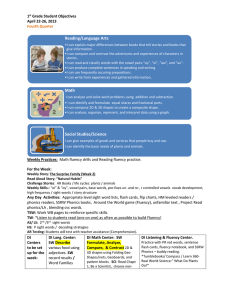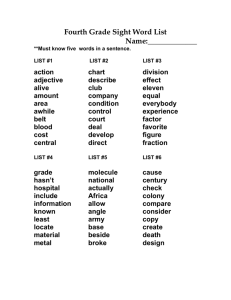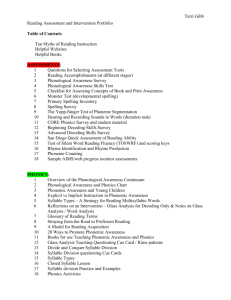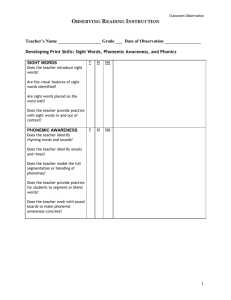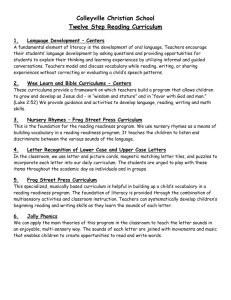Four Components Handout - Deborah Britton
advertisement
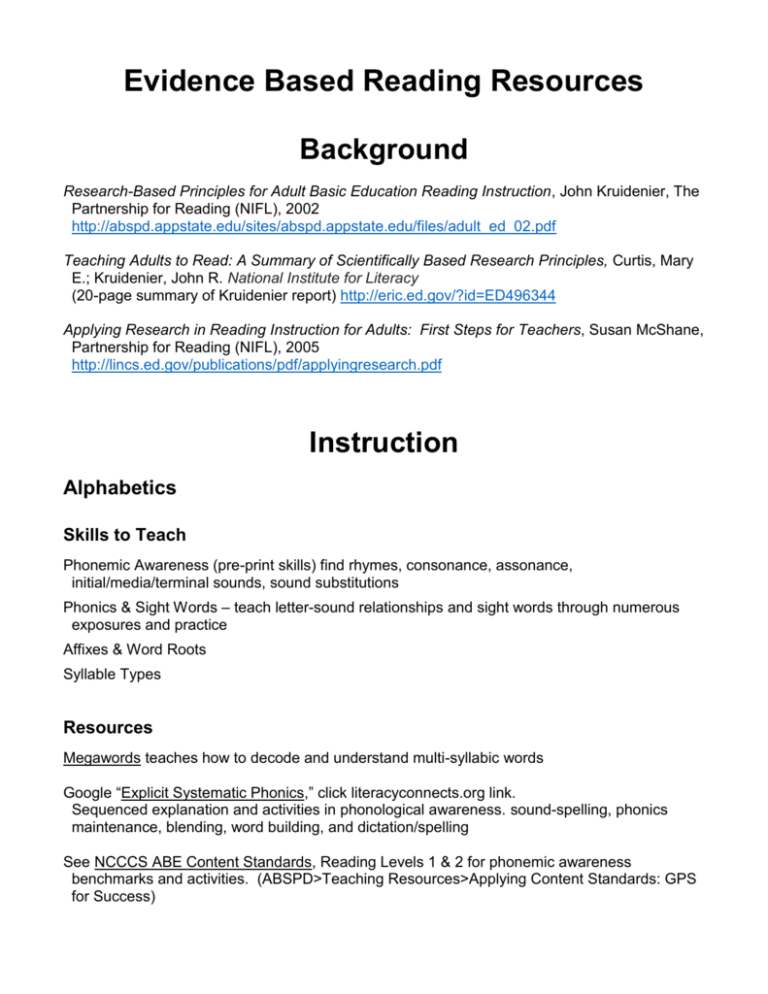
Evidence Based Reading Resources Background Research-Based Principles for Adult Basic Education Reading Instruction, John Kruidenier, The Partnership for Reading (NIFL), 2002 http://abspd.appstate.edu/sites/abspd.appstate.edu/files/adult_ed_02.pdf Teaching Adults to Read: A Summary of Scientifically Based Research Principles, Curtis, Mary E.; Kruidenier, John R. National Institute for Literacy (20-page summary of Kruidenier report) http://eric.ed.gov/?id=ED496344 Applying Research in Reading Instruction for Adults: First Steps for Teachers, Susan McShane, Partnership for Reading (NIFL), 2005 http://lincs.ed.gov/publications/pdf/applyingresearch.pdf Instruction Alphabetics Skills to Teach Phonemic Awareness (pre-print skills) find rhymes, consonance, assonance, initial/media/terminal sounds, sound substitutions Phonics & Sight Words – teach letter-sound relationships and sight words through numerous exposures and practice Affixes & Word Roots Syllable Types Resources Megawords teaches how to decode and understand multi-syllabic words Google “Explicit Systematic Phonics,” click literacyconnects.org link. Sequenced explanation and activities in phonological awareness. sound-spelling, phonics maintenance, blending, word building, and dictation/spelling See NCCCS ABE Content Standards, Reading Levels 1 & 2 for phonemic awareness benchmarks and activities. (ABSPD>Teaching Resources>Applying Content Standards: GPS for Success) For basic letter/sound correspondences, see Sylvia Greene’s Informal Word Analysis Inventory (phonics test) in ABSPD Teaching Resources Assessment Packet For most common sight words, google “common sight word list.” “300 Most Common Sight Words” is a good one. Reading Horizons: Computer-based phonics instruction Language Experience Approach: Literacy level reading technique in which text composed by the teacher and students is used for reading, vocabulary, and literacy activities. See “The Language Experience Approach and Adult Learners” at http://www.cal.org/caela/esl_resources/digests/LEA.html. The article is about ESL teaching but the technique is clearly described and can be applied to any learners. Syllable Types: Article “Six Syllable Types,” by Louisa Moats and Carol Tolman, at Reading Rockets: http://www.readingrockets.org/article/six-syllable-types --Also good syllable activities Syllable Rules: Phonics on the Web: http://www.phonicsontheweb.com/syllables.php Affixes and Word Roots: PrefixesSuffix.com – English Language Roots Reference In depth explanations and resources for understanding and teaching http://www.prefixsuffix.com/ Affixes: Quizlet.com - list of common affixes w/meanings and flashcards https://quizlet.com/669224/list-of-common-affixes-and-meanings-flash-cards/ Fluency Instructional Methods Echo Reading Repeated Reading Collaborative Oral Reading Marked Text Boundaries Remember to set specific fluency goals Resources ABSPD Lending Library will loan levelled books for free for a semester http://abspd.appstate.edu/fluency-texts For a short video about how to get Microsoft Word to read texts, see https://www.youtube.com/watch?v=vyP89pQWaBU “5 Sure-Fire Strategies for Developing Reading Fluency,” from Scholastic website http://www.scholastic.com/teachers/article/5-surefire-strategies-developing-reading-fluency “Fluency – Instructional Guidelines and Student Activities,” Reading Rockets website http://www.readingrockets.org/article/fluency-instructional-guidelines-and-student-activities Vocabulary Direct Instruction Using: Word Introduction: definition, personal context examples, quadrant chart Sentence Completion (first person / target word in sentence stem) Fill in the Blank Read and Respond Yes/No/Why Resources ABSPD website has 38 already prepared vocabulary lesson plans http://abspd.appstate.edu/vocabulary-lessons The Adult Learning Resource Center has 19 already prepared vocabulary lessons: http://www.thecenterweb.org/alrc/reading-pub.html ATLAS has 16 already prepared vocabulary lessons http://atlasabe.org/resources/ebri/ebri-vocabulary Tier 2 words: google The Academic Word List (School of Linguistics and Applied Language Studies. Victoria University, New Zealand). Click sublists in left column EPS Wordly Wise, McGraw Hill’s Words to Learn By and the Townsend Press Vocabulary Series are based on Tier 2 words. Bringing Words to Life: Robust Vocabulary Instruction, Isabel Beck, Margaret G. McKeown, and Linda Kucan. (2002). New York: Guilford Press. Comprehension Teaching Techniques Get the Gist Questioning KWL & Graphic Organizers Fix Up Strategies Text Marking Five most common text types for secondary academic text: Narrative Description Cause and Effect Compare and Contrast Sequence Resources Find levelled texts online at: ReadWorks.org Newsela.com Changeagent.nelrc.org ($20 for a one year subscription) Reading Skills for Today’s Adults http://resources.marshalladulteducation.org/reading_skills_home.htm For short nonfiction passages with graphic organizers that map their structure, see http://www.ereadingworksheets.com/text-structure/text-structure-worksheets “Questioning,” Sue Misiak, Advancing Adolescent Literacy Instruction Together¸ www.ohiorc.org/adlit/strategy/strategy_each.aspx?id=000003 “Summarizing,” Reading Quest.org http://www.readingquest.org/strat/summarize.html KWL chart w/prompts – Read Write Think – http://www.readwritethink.org/files/resources/lesson_images/lesson95/kwl_graph.pdf “Seven Strategies to Teach Students Reading Comprehension,” including graphic organizers – Reading Rockets http://www.readingrockets.org/article/seven-strategies-teach-students-text-comprehension Adapted from Deborah Britton, ABSPD Institute 2015
